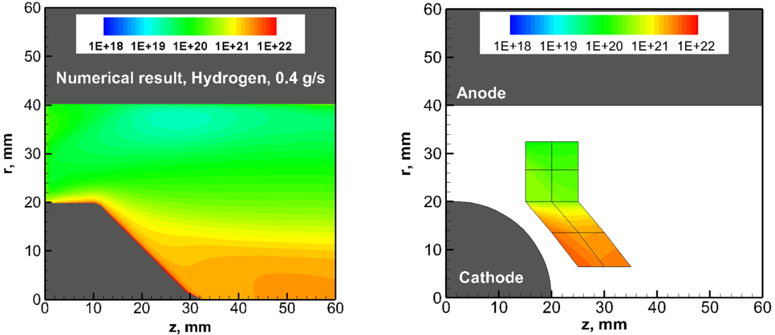Numerical Plasma Simulation on Advanced Space Propulsion Systems
JAXA Supercomputer System Annual Report April 2018-March 2019
Report Number: R18EU0904
Subject Category: Space and Astronautical Science
- Responsible Representative: Ikkoh Funaki, Associate Professor, ISAS
- Contact Information: Ikkoh Funaki(funaki.ikkoh@jaxa.jp)
- Members: Shitan Tauchi, Hiroyuki Arai, Ryota Hara
Abstract
Due to the limitation of the existing spacecraft technology level, it is very difficult to enable solar system explorations in a quick and cost-effective mannger. Objective of this study is to obtain a breakthrough spacecraft propulsion technology that enables solar system exploration of the next generations.
Reference URL
N/A
Reasons for using JSS2
Design optimization of spacecraft propulsion requires a huge computer resource, hence supercomputer usage is very important.
Achievements of the Year
To clarify the thruster performance and plasma behavior on a self-field magnetoplasmadynamic thruster (SF-MPDT) at the critical current operation using hydrogen as a propellant, the flow-field was simulated numerically. In the simulation code, the ion-slip effect is incorporated as a numerical model. The numerical simulation was conducted for discharge current J = 10 kA (critical current) and mass flow rate of 0.4 g/s, in order to understand the plasma conditions at the critical current level. At the critical current, the current path was extended to downstream of the discharge chamber by increasing ion-slip effect and Hall effect, therefore the pressure raised at cathode tip and the central axis. We validated the simulation code by comparison between numerical and experimental results, and the values of numerical results were in good agreement with experimental results as shown in Fig. 1
Secondary, to investigate the influence of the magnetic Reynolds number distribution on and thrust characteristics and the flow field of Magneto plasma sail, Magnetohydrodynamic analysis was conducted. In this numerical analysis, it was set a neutral particle diffusion distribution centered on the injection region, and the magnetic Reynolds number was evaluated locally to simulate Magneto plasma sail under more realistic conditions. Comparing these results with the results obtained under the ideal conditions (without the effect of the magnetic Reynolds number), it was showed that the plasma injection conditions for maximizing the thrust gain was different. It was found that the magnetic Reynolds number distribution affects the optimal plasma injection conditions.

Fig.1: The electron number density distribution. (H2, 0.4 g/s, left: numerical result, right: experimental results)
Publications
– Peer-reviewed papers
TAUCHI, S., KAWASAKI, A., NAKANE, M., KUBOTA, K., and FUNAKI, I., “The Effect of Anode Configuration on Hydrogen MPD Thruster Performance: A Numerical Study,” TRANSACTIONS OF THE JAPAN SOCIETY FOR AERONAUTICAL AND SPACE SCIENCES, AEROSPACE TECHNOLOGY JAPAN, vol. 16, 2018, pp. 274-279.
– Oral Presentations
Hiroyuki Arai, Yoshiki Yamagiwa, Yuya Oshio, Hiroyuki Nishida and Ikkoh Funaki, Numerical Analysis of the Thrust Characteristics of the Magneto Plasma Sail in the Non-uniform Magnetic Reynolds Number Condition, 69th International Astronautical Congress, IAC-18-C4.7-C3.5.11, Bremen, Oct. 2018.
Shitan Tauchi, Akira Kawasaki, Masakatsu Nakane, Kenichi Kubota, Ikkoh Funaki, Numerical Analysis of the Effect of Cathode Configuration on Hydrogen MPD Thruster Performance, Asian Joint Conference on Propulsion and Power, AJCPP2018-027, Mar. 2018, Xiamen.
Usage of JSS2
Computational Information
- Process Parallelization Methods: N/A
- Thread Parallelization Methods: Automatic Parallelization
- Number of Processes: 1
- Elapsed Time per Case: 10 Hour(s)
Resources Used
Fraction of Usage in Total Resources*1(%): 0.02
Details
Please refer to System Configuration of JSS2 for the system configuration and major specifications of JSS2.
| System Name | Amount of Core Time(core x hours) | Fraction of Usage*2(%) |
|---|---|---|
| SORA-MA | 90,261.84 | 0.01 |
| SORA-PP | 1,812.07 | 0.01 |
| SORA-LM | 0.00 | 0.00 |
| SORA-TPP | 0.00 | 0.00 |
| File System Name | Storage Assigned(GiB) | Fraction of Usage*2(%) |
|---|---|---|
| /home | 47.68 | 0.05 |
| /data | 476.84 | 0.01 |
| /ltmp | 9,765.63 | 0.84 |
| Archiver Name | Storage Used(TiB) | Fraction of Usage*2(%) |
|---|---|---|
| J-SPACE | 0.00 | 0.00 |
*1: Fraction of Usage in Total Resources: Weighted average of three resource types (Computing, File System, and Archiver).
*2: Fraction of Usage:Percentage of usage relative to each resource used in one year.
JAXA Supercomputer System Annual Report April 2018-March 2019


